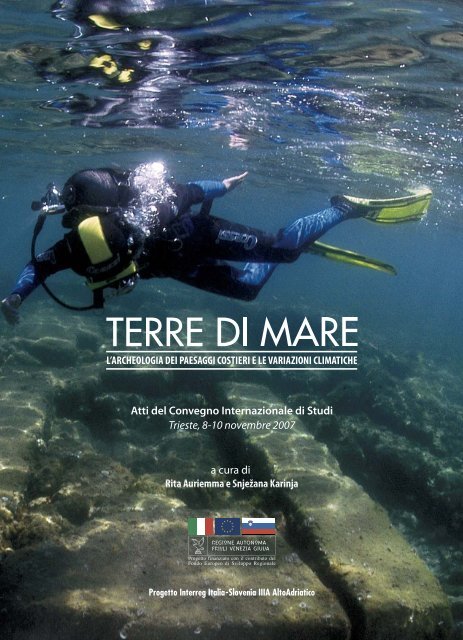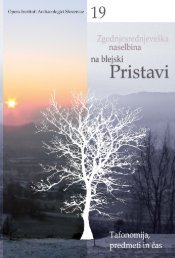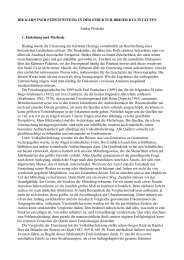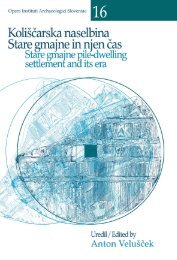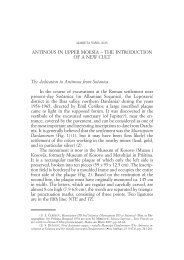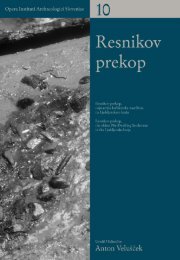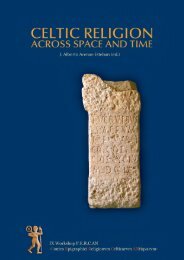Atti del Convegno Internazionale di Studi Trieste, 8-10 novembre 2007
Atti del Convegno Internazionale di Studi Trieste, 8-10 novembre 2007
Atti del Convegno Internazionale di Studi Trieste, 8-10 novembre 2007
You also want an ePaper? Increase the reach of your titles
YUMPU automatically turns print PDFs into web optimized ePapers that Google loves.
<strong>Atti</strong> <strong>del</strong> <strong>Convegno</strong> <strong>Internazionale</strong> <strong>di</strong> Stu<strong>di</strong><br />
<strong>Trieste</strong>, 8-<strong>10</strong> <strong>novembre</strong> <strong>2007</strong><br />
a cura <strong>di</strong><br />
Rita Auriemma e Snježana Karinja
Il volume, pubblicato nell’ambito <strong>del</strong> Progetto Interreg IIIA Italia-Slovenia AltoAdriatico<br />
(I siti costieri <strong>del</strong>l’alto arco adriatico: indagini topografiche a terra e a mare)<br />
è stato stampato con il contributo <strong>del</strong>la Fondazione Benefica Kathleen Foreman Casali,<br />
<strong>del</strong>la Fondazione Cassa <strong>di</strong> Risparmio <strong>di</strong> <strong>Trieste</strong> e <strong>del</strong>la Società T.O. DELTA.<br />
In copertina: Punta Sottile, Muggia (Ts): il molo romano (foto Fabrizio Antonioli - ENEA).<br />
Cartografia informatizzata: Dorotea Riccobono<br />
Sistema informativo geografico su DVD allegato: Michele Fernetti<br />
Impaginazione: GB Comunicazione - <strong>Trieste</strong><br />
Le immagini <strong>di</strong> beni <strong>di</strong> proprietà <strong>del</strong>lo Stato Italiano vengono <strong>di</strong>ffuse su concessione <strong>del</strong> Ministero per i Beni e le <strong>Atti</strong>vità<br />
Culturali, Soprintendenza per i Beni Archeologici <strong>del</strong> Friuli Venezia Giulia.<br />
È vietata l’ulteriore riproduzione o duplicazione <strong>del</strong>l’immagine con qualsiasi mezzo senza l’autorizzazione <strong>del</strong>la Soprintendenza<br />
stessa.<br />
© 2008 - Università degli Stu<strong>di</strong> <strong>di</strong> <strong>Trieste</strong><br />
Dipartimento <strong>di</strong> Scienze <strong>del</strong>l’Antichità “Leonardo Ferrero”<br />
via <strong>del</strong> Lazzaretto Vecchio, 6 - 34123 <strong>Trieste</strong>, Italia<br />
tel.: +390405582800; fax: +390405582804 - 2814<br />
e-mail: norio@units.it<br />
© 2008 - Pomorski muzej - Museo <strong>del</strong> mare “Sergej Mašera” Piran - Pirano<br />
Cankarjevo nabrežje 3, SI - 6330 Piran, Slovenija<br />
tel.: +386(0)567<strong>10</strong>040; fax.: +386(0)567<strong>10</strong>050<br />
e-mail: muzej@pommuz-pi.si
In<strong>di</strong>ce<br />
Presentazione<br />
Gino Ban<strong>del</strong>li ......................................................................................................................................................................................... 11<br />
Monika Verzár .......................................................................................................................................................................................12<br />
Martina Gamboz ....................................................................................................................................................................................14<br />
Flavio Bonin ...........................................................................................................................................................................................15<br />
Il Progetto Interreg Italia-Slovenia IIIA AltoAdriatico: risultati e prospettive<br />
Rita Auriemma, Snježana Karinja.......................................................................................................................................................... 17<br />
I Sessione<br />
Il progetto Interreg “AltoAdriatico”: risultati e prospettive<br />
I castellieri <strong>di</strong> <strong>Trieste</strong> tra Carso e mare<br />
Ambra Betic, Federico Bernar<strong>di</strong>ni, Emanuela Montagnari Kokelj ..........................................................................................................25<br />
Il sito <strong>di</strong> Zaule presso <strong>Trieste</strong> (Italia nord-orientale)<br />
Federico Bernar<strong>di</strong>ni, Ambra Betic .........................................................................................................................................................38<br />
Sermino protostorica e i castellieri <strong>del</strong> litorale sloveno<br />
Maša Sakara Sučević .............................................................................................................................................................................44<br />
Archaeological research of maritime infrastructure of Roman settlements<br />
on the Slovenian coast of Istria (1993-<strong>2007</strong>)<br />
Marko Stokin, Andrej Gaspari, Snježana Karinja, Miran Erič ..................................................................................................................56<br />
Terre <strong>di</strong> mare: paesaggi costieri dal Timavo alla penisola muggesana<br />
Rita Auriemma, Valentina Degrassi, Patrizia Donat, Dario Gad<strong>di</strong>, Susanna Mauro, Flaviana Oriolo, Dorotea Riccobono .......................75<br />
I sistemi portuali e gli inse<strong>di</strong>amenti costieri in epoca me<strong>di</strong>evale<br />
dalle Foci <strong>del</strong> Timavo a Muggia<br />
Pietro Riavez ....................................................................................................................................................................................... 213<br />
Archaeological and geomorphological data to deduce sea level changes during<br />
the late Holocene in the Northeastern Adriatic<br />
F. Antonioli, S. Furlani, K. Lambeck, F. Stravisi, R. Auriemma, D. Gad<strong>di</strong>, A. Gaspari, S. Karinja, V. Kovačić ...........................................221<br />
II Sessione<br />
Geomorfologia: dal paleopaesaggio agli assetti costieri <strong>del</strong> futuro.<br />
Le evidenze archeologiche sommerse come markers <strong>del</strong>le variazioni<br />
<strong>del</strong> livello <strong>del</strong> mare<br />
Sea level change and archaeological coastal sites: an inter<strong>di</strong>sciplinary approach applied<br />
along the south-eastern coast of Sicily<br />
Gianfranco Scicchitano, Fabrizio Antonioli, Elena Flavia Castagnino Berlinghieri, Carmelo Monaco ...................................................239<br />
Mo<strong>di</strong>ficazioni <strong>del</strong>la linea <strong>di</strong> costa nella laguna <strong>di</strong> Sulki in epoca punico-romana<br />
(Isola <strong>di</strong> S. Antioco, Sardegna sud-occidentale)<br />
Paolo Orrù, Emanuela Solinas, Elisabetta Frau .................................................................................................................................... 247<br />
Notch development inferred by limestone lowering rates in Northeastern Adriatic<br />
Stefano Furlani, Franco Cucchi, Anna Rossi, Roberto Odorico ..............................................................................................................257
Il porto e la peschiera <strong>di</strong> Miseno (NA): nuovi dati archeologici per lo stu<strong>di</strong>o <strong>del</strong>le variazioni<br />
<strong>del</strong> livello <strong>del</strong> mare nell’area flegrea<br />
Alessandra Benini ...............................................................................................................................................................................269<br />
Strutture portuali <strong>di</strong> Via dei Cavazzeni (<strong>Trieste</strong>): in<strong>di</strong>cazioni sul livello <strong>del</strong> mare<br />
Valentina Degrassi, Stefano Furlani, Franca Maselli Scotti, Romana Melis, Fabrizio Antonioli, Giulia Fonda ....................................... 275<br />
III Sessione<br />
Portualità marittima e infrastrutture nel Me<strong>di</strong>terraneo.<br />
Tipologie e<strong>di</strong>lizie, tecniche costruttive e rapporti con il territorio<br />
Recenti scoperte sottomarine nella baia <strong>di</strong> Kaštela<br />
Irena Ra<strong>di</strong>ć Rossi .................................................................................................................................................................................285<br />
Underwater archaeological research at the Vižula peninsula near Medulin<br />
Igor Miholjek .......................................................................................................................................................................................299<br />
Dragonera. Due ville romane.<br />
Alka Starac ..........................................................................................................................................................................................304<br />
Quatre ans de recherche sur le littoral parentin<br />
M.-B. Carre, V. Kovačić, F. Tassaux, ...................................................................................................................................................... 3<strong>10</strong><br />
Il porto <strong>di</strong> Tergeste: riflessioni a seguito dei recenti rinvenimenti<br />
Franca Maselli Scotti ........................................................................................................................................................................... 317<br />
Le strutture portuali <strong>di</strong> via Cavana a <strong>Trieste</strong><br />
Paola Ventura, Valentina Degrassi, Gabriella Petrucci.........................................................................................................................328<br />
Il paesaggio costiero antico nella Laguna nord <strong>di</strong> Venezia: recenti acquisizioni<br />
dall’archeologia subacquea<br />
Marco D’Agostino, Luigi Fozzati, Alberto Lezziero, Marco Marchesini, Stefano Medas .......................................................................340<br />
La <strong>di</strong>namica inse<strong>di</strong>ativa <strong>del</strong>la Laguna <strong>di</strong> Venezia: alcuni casi <strong>di</strong> stu<strong>di</strong>o dalla Laguna nord<br />
Massimo Capulli, Luigi Fozzati, Alberto Lezziero, Alessandro Pellegrini .............................................................................................349<br />
Archeologia <strong>del</strong>la costa: la situazione marchigiana<br />
Maria Cecilia Profumo .........................................................................................................................................................................360<br />
Le strutture portuali romane in cementizio:<br />
questioni progettuali, problemi cronologici.<br />
Enrico Felici .........................................................................................................................................................................................369<br />
The construction of the Hero<strong>di</strong>an harbour of Caesarea Palaestina<br />
Christopher J. Brandon .......................................................................................................................................................................377<br />
IV Sessione<br />
Paesaggi e mo<strong>del</strong>li inse<strong>di</strong>ativi<br />
Le ville costiere tra la fine <strong>del</strong>la Repubblica e gli inizi <strong>del</strong>l’Impero:<br />
il quadro <strong>del</strong>le fonti letterarie<br />
Pasquale Rosafio .................................................................................................................................................................................387<br />
L’indagine archeologica e paleoambientale <strong>del</strong> complesso costiero <strong>di</strong> Loron - Istria:<br />
spunti per un mo<strong>del</strong>lo interpretativo.<br />
Antonio Marchiori, Daniele Giar<strong>di</strong>no ...................................................................................................................................................392<br />
Il Porto Quieto e il fiume: un mutare <strong>di</strong> funzioni e <strong>di</strong> paesaggi tra l’Istria costiera e l’interno<br />
Chiara D’Incà .......................................................................................................................................................................................400<br />
Analiza razmerja med rimsko poselitvijo in bližino obale v severozahodni Istri<br />
Sašo Poglajen ......................................................................................................................................................................................408
Il quartiere episcopale <strong>di</strong> un emporio altome<strong>di</strong>evale.<br />
Gli scavi nel centro storico <strong>di</strong> Comacchio e la sequenza dei materiali.<br />
Sauro Gelichi, Clau<strong>di</strong>o Negrelli, Diego Calaon, Elena Gran<strong>di</strong> ................................................................................................................ 416<br />
V Sessione<br />
Merci, trasporti e contatti nell’alto Adriatico<br />
Rapporti circumadriatici in età preromana:<br />
la <strong>di</strong>ffusione <strong>del</strong>la ceramica <strong>di</strong> produzione daunia in alto Adriatico<br />
Nicoletta Poli ...................................................................................................................................................................................... 431<br />
La ceramica grigia nei siti costieri <strong>del</strong>l’Alto Adriatico orientale.<br />
Una produzione a Stramare <strong>di</strong> Muggia?<br />
Patrizia Donat, Renata Merlatti ..........................................................................................................................................................435<br />
The beginning of Roman commerce along the main route Aquileia - Emona<br />
Jana Horvat .........................................................................................................................................................................................444<br />
Merci, trasporti e contatti nella Venetia:<br />
le importazioni <strong>di</strong> anfore olearie dal Me<strong>di</strong>terraneo orientale<br />
Chiara Belotti ......................................................................................................................................................................................454<br />
Trade and consumption of foodstuffs in Northern Adriatic:<br />
the case of the villa Školarice<br />
Tina Žerjal............................................................................................................................................................................................462<br />
Lo sfruttamento <strong>del</strong>le risorse marine a <strong>Trieste</strong> in età romana:<br />
i dati dai recenti scavi <strong>di</strong> Crosada <strong>di</strong> Cavana<br />
Gabriella Petrucci ................................................................................................................................................................................470<br />
La mostra “Terre <strong>di</strong> Mare”<br />
La mostra “Terre <strong>di</strong> mare”<br />
Rita Auriemma, Snježana Karinja........................................................................................................................................................479<br />
L’atleta <strong>del</strong>la villa <strong>di</strong> Barcola<br />
Giulia Mian ..........................................................................................................................................................................................486<br />
Elenco Autori .............................................................................................................................................................................492<br />
Progetto Interreg Italia-Slovenia IIIA AltoAdriatico: Carta Archeologica<br />
Projekt Interreg Italija-Slovenija IIIA AltoAdriatico: Arheološka karta<br />
Elenco UT | Koda TE Poimenovanje ..........................................................................................................................................496<br />
Tavola fuori testo<br />
Progetto Interreg Italia-Slovenia IIIA AltoAdriatico: Carta Archeologica<br />
Projekt Interreg Italija-Slovenija IIIA AltoAdriatico: Arheološka karta
444<br />
Jana<br />
Horvat<br />
The beginning of Roman commerce along the<br />
main route Aquileia - Emona<br />
Abstract<br />
An important old route connecting the Italian peninsula with the central Danube region began at<br />
Aquileia and crossed the low-lying passes between the Julian Alps and the Dinaric Mountains. Selected<br />
archaeological sites in the Postojna and Ljubljana basins are <strong>di</strong>scussed with the aim of identifying the<br />
stages of the trade development during the 2 nd and 1 st centuries BC: Grad near Šmihel (the first half of<br />
the 2 nd century BC), numismatic evidence (the middle of the 2 nd century BC), the Razdrto Pass (the end of<br />
the 2 nd and the first third of the 1 st century BC), Nauportus and Emona (Augustan period).<br />
The foun<strong>di</strong>ng of the Roman colony of Aquileia in 181 BC and the occupation of Histria in<br />
178/177 BC had a profound effect on the north-eastern Adriatic area. 1<br />
By the middle of the 2 nd century BC, Roman ceramics (and other goods) were well represented<br />
in the coastal sites of north-western Istria. The best evidence for this was provided by the<br />
site of Sermin, probably a kind of a coastal emporium, where a large amount of later Greco-<br />
Italic amphoras originating from the Adriatic production centres had been deposited. 2 The<br />
settlements multiplied from the end of the 2 nd century BC onwards, offering an insight into<br />
the wide <strong>di</strong>ffusion of the Roman material, e. g. fine and common ceramics as well as amphoras<br />
Lamboglia 2, in the coastal zone. 3 On the other hand, the archaeological traces of the<br />
Romans in the mainland territory east of Aquileia in the 2 nd century BC are very sparse.<br />
Contacts and tra<strong>di</strong>ng with the peoples of the south-eastern Alpine area were of primary<br />
importance to Aquileia from the outset. 4 An important old route connecting the Italian<br />
peninsula with the central Danube region began at Aquileia and crossed the low-lying<br />
passes between the Julian Alps and the Dinaric Mountains (Fig. 1). Going eastwards<br />
from Aquileia, the first pass was Razdrto (598 m asl), situated at the western edge of<br />
the Postojna basin. The latter represented the crossroads of routes lea<strong>di</strong>ng from Aquileia,<br />
Tergeste, northern Istria and the Kvarner Bay. After that, the main route descended<br />
down to the Ljubljana basin, to the springs of the Ljubljanica river. There an old navigable<br />
route began that enabled transport far into the East along the Ljubljanica, Sava and<br />
Danube rivers. 5 Actually, two old long-<strong>di</strong>stance communications fork in the area of the<br />
Ljubljana basin, the so-called Amber Route lea<strong>di</strong>ng northwards (Aquileia - Celeia - Carnuntum<br />
- the Baltic Sea) and the route along the Sava river, also called the Argonaut’s<br />
Route (Caput Adriae - the Sava - the Danube - the Black Sea). 6<br />
The text below will <strong>di</strong>scuss selected archaeological sites along the main south-eastern<br />
Alpine route, in the Postojna and Ljubljana basins, with the aim of identifying the stages<br />
of the trade development during the 2 nd and 1 st centuries BC. The specific types of material<br />
traded will, for the most part, be neglected. 7<br />
The Postojna basin<br />
Grad near Šmihel<br />
An important prehistoric hillfort at Grad near Šmihel commanded the Postojna basin<br />
and the 7 km <strong>di</strong>stant Razdrto Pass. A large hoard was <strong>di</strong>scovered there, which predominantly<br />
contained Roman weapons for <strong>di</strong>stance fighting: heavy and light pila, incen<strong>di</strong>ary<br />
pila, javelins, catapult bolts, arrowheads and swords. Many of them were deformed -<br />
evidently previously used in battle. Based on the pila with flat hafts, the hoard could<br />
be dated to the end of the 3rd and the first half of the 2nd century BC. Historical circumstances,<br />
on the other hand, rather in<strong>di</strong>cate a burial from the first half of the 2nd century<br />
BC. The hoard should be tied to the otherwise unknown Roman military activity in the<br />
hinterland of Aquileia, which probably intended to establish control over the route and<br />
open the path for Roman trade towards the east. 8<br />
1 Šašel Kos 1997.<br />
2 Horvat 1997a, pp. 98-99, 118-120, 123, fig. 47; Kirigin 1994.<br />
3 Horvat 1995a; Horvat 1997a, pp. 120-130.<br />
4 Šašel Kos 1997.<br />
5 Šašel 1966; Šašel 1977; Tassaux 2004.<br />
6 Buora 1996; Šašel Kos 1997, pp. 34-38; Šašel Kos 2006.<br />
7 North-eastern Italian brooches: Demetz 1999; Božič 2008, forthcoming. Ceramics: Bezeczky 1987; Horvat<br />
1995a; Horvat 1997a, 118-130.<br />
8 Horvat 2002; Kmetič, Horvat, Vodopivec 2004; Horvat 1997b; Connoly 2000; Guštin, Gaspari 2005, pp.<br />
356-357.
Numismatic evidence<br />
The numismatic evidence was carefully stu<strong>di</strong>ed and interpreted by Alenka Miškec. Victoriatii, which are dated to<br />
the first half of the 2 nd century BC, appear in considerable number in the south-western part of Slovenia as in<strong>di</strong>vidual<br />
finds and in three hoards: from the Ljubljanica river (at the confluence with the Zrnica river), at Baba near<br />
Slavina and Gra<strong>di</strong>šče near Knežak. The hoards are dated with the latest coins shortly after the middle of the 2 nd<br />
century BC (the Ljubljanica 147 BC, Baba 146 BC, Knežak 146 BC). The Roman coins along the Amber Route demonstrate<br />
a strong Roman influence in the mid-2 nd century BC. The complete lack of such coins in areas further to<br />
the north, and particularly in the Norican Kingdom, undoubtedly in<strong>di</strong>cates the course of Roman penetration - the<br />
active policy in the middle of the 2 nd century BC was <strong>di</strong>rected towards the Balkans. 9<br />
Ocra - Razdrto<br />
The Razdrto Pass (597 m asl) and the Nanos hill (1261 m asl) that rises above it are both mentioned in the classical<br />
literary sources with the same name - Ocra. <strong>10</strong> The Nanos is exceptionally imposing and visible from far away, also<br />
from the lowlands near Aquileia. Razdrto should therefore be regarded as a first-class traffic and strategic point,<br />
where some aspects of the transit traffic could be preserved in the archaeological record. 11<br />
The area of Razdrto reveals a concentration of archaeological sites (Fig. 2). Their chronology in<strong>di</strong>cates periods of<br />
increased traffic across the pass: the Middle and Late Bronze Ages (Šušec, Goli vrh), the Late La Tène and Early Roman<br />
periods through to the early 1st century AD (Šušec, Preval, Mandrga, Goli vrh) as well as the Late Roman period<br />
(Preval, Žingarca). 12<br />
The area revealed also the remains of the Roman road; they were excavated on the top of the pass - at Preval - and at<br />
Šušec west of the pass, on a sheltered terrace on the slopes of the Nanos. 13 The archaeological remains can be interpreted<br />
as resting posts with an isolated buil<strong>di</strong>ng stan<strong>di</strong>ng on each of the two sites. A small settlement site of Mandrga<br />
500 m east of the pass is most likely not situated far from the Roman road. The sites at Goli vrh, Žingarca and Gra<strong>di</strong>šče,<br />
on the other hand, were positioned above the pass, on the hills affor<strong>di</strong>ng protection and a good view over a large<br />
area. In the shortage of extensive archaeological research, these can be regarded primary as control points. 14<br />
The site of Mandrga provided a lot of Roman material, though no built structures were identified during the excavations.<br />
Studying the field documentation and the composition of small finds, however, led to the supposition<br />
that the remains of one or two wooden buil<strong>di</strong>ngs were probably <strong>di</strong>scovered there. 15 The small finds are remarkably<br />
uniform, regar<strong>di</strong>ng both chronology and provenience. The site yielded almost exclusively Roman material of a<br />
Late Republican date; there were very few exceptions. 16<br />
The site revealed a large amount of potsherds belonging to wine amphoras of the Lamboglia 2 type (Fig. 3). This amphora<br />
type was produced in the central and northern Adriatic area from the last quarter of the 2nd to the third quarter<br />
of the 1st century BC. The form <strong>di</strong>d witness a certain development in the course of almost a century of production, but<br />
this is <strong>di</strong>fficult to define and identify. 17 For the amphoras from Razdrto it seems that they should be positioned well<br />
before the appearance of the latest forms that show traits of transition to the later amphoras Dr. 6 A. 18<br />
The forms of the black glazed pottery found at Mandrga (Fig. 4: 1-7) are common in various production circles of Campanian<br />
ceramics in the second half of the 2nd and in the 1st century BC. The fabric of most fragments is very uniform. Some<br />
forms, such as the conical bowls with emphasized rim edges (forms Morel 2652-2653; Fig. 4: 5) and the plate with a<br />
stamp in the form of a double C (Fig. 4: 7), in<strong>di</strong>cate the origin of the whole group of ceramics in the north Etruscan circle<br />
of black glazed (Campanian) ceramics. 19 Forms such as deep plates with curving walls (Fig. 4: 1), plates with very broad<br />
undulated rims (Fig. 4: 3-4), bowls with simple everted rims (Fig. 4: 2) and conical bowls with emphasized rim edges and<br />
rounded profile (Fig. 4: 5) date mostly to the end of the 2nd or in the first third of the 1st century BC. 20 The absence of the<br />
so-called “porous fabric” known from Magdalensberg or the “central Padanian black glazed pottery” are also of chronological<br />
importance - they show that the site of Mandrga predates the large-scale <strong>di</strong>stribution of the “porous fabric”. 21<br />
To conclude, the forms of the black glazed pottery and the Lamboglia 2 amphoras in<strong>di</strong>cate the chronological position<br />
of Mandrga at the end of the 2nd or the first third of the 1st century BC.<br />
Other types of ceramics were also being imported from Italy in that period: high thin-walled beakers (types Marabini<br />
3 and 4; Fig. 4: 8), Italian common ware (jugs, bowls in grey ware of the Venetian tra<strong>di</strong>tion; Fig. 4: 9) and<br />
Italian cooking ware (pots with almond rims, baking <strong>di</strong>shes without a slip and accompanying lids; Fig. 4: <strong>10</strong>-13). 22<br />
The cooking ware of local tra<strong>di</strong>tion is very poorly represented (perhaps a small part of pots and baking rings).<br />
9 Miškec 2003; Kos, Šemrov 2003.<br />
<strong>10</strong> Šašel 1974; Šašel 1977.<br />
11 Horvat 2005, 237-242; Guštin, Gaspari 2005.<br />
12 Horvat 2005; Bavdek 1996; Svoljšak 2003.<br />
13 Svoljšak 2003; Bavdek, Horvat, forthcoming.<br />
14 Horvat 2005, pp. 241-242.<br />
15 Bavdek, Horvat, forthcoming.<br />
16 Bavdek 1996, pp. 298-299. Bavdek, Horvat, forthcoming.<br />
17 Carre 1985, p. 211; Cipriano, Carre 1989, pp. 80-85; Bruno 1995, pp. 15-38; Horvat 1997a, p. 58; Pesavento Mattioli 2000, p. <strong>10</strong>8.<br />
18 Horvat 1997a, pp. 60-67, 71-74.<br />
19 Morel 1987, pp. 120-126; Brecciaroli Taborelli 2005, pp. 71-73.<br />
20 Frontini 1985; Sfredda 1998.<br />
21 Schindler 1986, pp. 354-361; Olcese 1998, pp. 11-14; Horvat 1995a, pp. 30-36.<br />
22 Fasano 1994; Santoro Bianchi 2005; Bats 1993, pp. 358-361; Olcese 2003, pp. 26-27.<br />
445
446<br />
Fig. 1. The main route Aquileia - Emona in the 1st century BC.<br />
Fig. 2. Archaeological sites in the area of the Razdrto Pass.
The archaeological material from Mandrga does not <strong>di</strong>ffer from the contemporary deposits in north-eastern Italy<br />
and Istria. Probably the best comparison is that of the deposit from Fornače near Piran, on the coast of north-western<br />
Istria. It revealed a great quantity of the earlier Lamboglia 2 amphoras, but also black glazed pottery similar to<br />
that from Mandrga, a Megarian cup of the Ephesian-Ionian type, thin-walled Marabini 1 and 3 beakers and Italian<br />
cooking ware (baking <strong>di</strong>shes and lids). 23<br />
The area of Notranjska, where Mandrga is situated, saw the prevalence of fortified hilltop settlements in the La<br />
Tène period. Contacts with the Roman world, which can be observed on these in<strong>di</strong>genous sites, were mostly limited<br />
to the circulation of Roman coins - alongside Celtic silver coins. The profound influence and wide-scale use of<br />
Roman products in daily life can be noticed only from the middle Augustan period onwards. 24 Therefore, Mandrga<br />
appears to be a foreign element within the autochthonous environment at the end of the 2 nd or beginning of the<br />
1 st century BC - an outpost of the Romans on a strategic site that exerted control over the road towards the east.<br />
It seems that the Adriatic wine amphoras from Razdrto - Mandrga represent a material proof for the wine trade<br />
at the end of the 2 nd or beginning of the 1 st century BC. The scarce finds from the consumer sites, with the only<br />
exception of Magdalensberg, 25 in<strong>di</strong>cate a limited extent of the wine trade in the Eastern Alps and Middle Danubian<br />
area. 26 It should also be noted that no oil amphoras were found at Razdrto - Mandrga.<br />
The Ljubljana basin<br />
Nauportus<br />
The key strategic point in central Slovenia was Nauportus, situated at the western edge of the Ljubljana basin, in<br />
the area of present-day Vrhnika, and at the beginning of the river route along the Ljubljanica, Sava and Danube.<br />
Strabo reports, for the 2nd century BC, that goods were being transported by wagons from Aquileia to Nauportus,<br />
a settlement of the Celtic Taurisci, then reloaded onto ships that navigated the rivers to the Danube. 27 The settlement’s<br />
name and historical analogies provide the basis for inferring that a toll station existed at Nauportus. However,<br />
the position of the Celtic Nauportus from the 2nd century BC is not known. 28<br />
The settlement enjoyed the status of vicus in the territory of Aquileia from the middle of the 1st century BC onwards.<br />
During the 1st century BC, important Aquileian merchant families maintained control over the vicus via their<br />
freedmen; they also controlled the transit of the long-<strong>di</strong>stance traffic that passed by Nauportus. The historical and<br />
epigraphic data lead to the conclusion that immigration from Italy was quite considerable from the very start. 29<br />
The Early Roman Nauportus was situated on the plain, where the Ljubljanica bends towards the moor of the<br />
Ljubljansko barje. 30 The Roman road Aquileia - Emona, which was probably constructed under Augustus, led along<br />
the western bank of the Ljubljanica through the settlement area at Breg. This part of the settlement has its origins<br />
in the Middle Augustan period and was uninterruptedly occupied through to the 4th century. 31<br />
Dolge njive, the eastern and best known part of the Early Roman settlement, lay inside the meander of the Ljubljanica<br />
river bend. The new ground plan of the site, which was engendered by geophysical prospection and the combination<br />
of this with the ground plans resulting from former excavations, has a good interpretative potential (Fig. 5). 32<br />
The Dolge njive site measured 130 x 144 m. The Ljubljanica river flows along two sides of the site; while a defence<br />
<strong>di</strong>tch filled with water ran along the eastern and probably also the southern sides. The defence wall with four<br />
protru<strong>di</strong>ng square towers was 2-3 m wide at the southern and eastern sides, while the back walls of the buil<strong>di</strong>ngs<br />
formed a less than 1 m wide defence wall at the western and northern ends. 33<br />
The central market, which has an irregular form of a parallelogram, covers about 30 % of the site surface. A large<br />
area is built-up with storehouses - horrea: rows of buil<strong>di</strong>ngs with long and narrow rooms, wide entrances and a<br />
portico. They occupy about 30 % of the area, that is about 5.500 m2 (Buil<strong>di</strong>ngs 2-5, 11-17, 19-20, 22-23). The entrances<br />
face towards the market and cover the entire width of the rooms. The type of horrea with rooms lined in<br />
a row was well known throughout the Roman world primarily in ports; the entrances to the rows of storehouses<br />
were frequently open towards the piers in ports. The type appears in various parts of the Empire during a large<br />
chronological span from the 1st century BC through to the 2nd century AD. 34<br />
The long and narrow buil<strong>di</strong>ng with eight rooms (21) probably functioned, based on its form and <strong>di</strong>mensions, as a<br />
row of tabernae. 35 The relatively small buil<strong>di</strong>ng (25), situated in the corner of the market and not hol<strong>di</strong>ng a dominant<br />
position, had a ground plan similar to that of a particular type of sanctuaries with ambulatories in which the<br />
Celtic tra<strong>di</strong>tion intermingled with Roman elements. 36 The river port was situated just north of the built-up area.<br />
23 Stokin 1992; Horvat 1995a; Horvat 1997a, pp. 73-74, fig. 27, tab. 59-65.<br />
24 Horvat 1995b; Horvat 2005.<br />
25 Maier-Maidl 1992, p. 13.<br />
26 Bezeczky 1994a, pp. 13-15; Bezeczky 1994b, p. 81; Tassaux 2004, pp. 170-174.<br />
27 Šašel Kos 1990, pp. 17-19, 143-145.<br />
28 Šašel 1966; Šašel Kos 1990, pp. 20, 146-147.<br />
29 Šašel Kos 1990; Šašel Kos 1998; Šašel Kos 2000, 294-297; Šašel Kos 2002.<br />
30 Horvat 1990.<br />
31 Horvat, Mušič <strong>2007</strong>, pp. 167-171.<br />
32 Mušič, Horvat <strong>2007</strong>.<br />
33 Mušič, Horvat <strong>2007</strong>, pp. 233-238, 261-262.<br />
34 Mušič, Horvat <strong>2007</strong>, pp. 238-244, 262-264.<br />
35 Mušič, Horvat <strong>2007</strong>, pp. 244-245, 264.<br />
36 Mušič, Horvat <strong>2007</strong>, pp. 249-250, 264.<br />
447
448<br />
Fig. 3. Lamboglia 2 amphoras from Razdrto. Scale 1:4
Fig. 4. Black glazed ware, thin-walled pottery, grey pottery of Venetian tra<strong>di</strong>tion and Italian cooking ware from Razdrto. Scale 1:4<br />
(a stamp 1:1).<br />
449
450<br />
The majority of small finds from the old archaeological excavations at Dolge njive lacks detailed stratigraphic data.<br />
However, the forms of the black glazed pottery and its <strong>di</strong>stribution demonstrate that most of the settlement was<br />
probably constructed in the Pre-Augustan or Early Augustan period. Small finds also show that the decline of the<br />
settlement at Dolge njive occurred during the first half of the 1 st century AD. 37<br />
The main characteristic of Nauportus - Dolge njive is its key position at the junction between land routes lea<strong>di</strong>ng<br />
from north-eastern Italy and Istria and water routes lea<strong>di</strong>ng eastwards. The large storehouses, market and fortifications<br />
lead us to infer that the site of Dolge njive acted as a reloa<strong>di</strong>ng tra<strong>di</strong>ng post, where long-<strong>di</strong>stance transit<br />
traffic and trade could operate. The extensiveness of the complex points to an exceptionally large amount of traffic<br />
and goods, particularly in the Augustan period. In ad<strong>di</strong>tion to the regular merchant traffic, military shifts and supplies<br />
also passed through Nauportus. It has to be noted that further down along the Sava, in the Brežice gateway<br />
that opens into the Pannonian plain, a whole series of military camps dating to the Augustan period is known. 38<br />
Emona<br />
Emona was situated at an old crossroads in the centre of the Ljubljana basin, just 20 km east from Nauportus. The<br />
settlement existed there in the second half of the 1st century BC on the right bank of the Ljubljanica river, in the<br />
area of Stari and Gornji trg. The earliest strata from the Late Republican or Early Augustan period revealed local<br />
coarse wares, fine La Tène wares as well as several types of Italic pottery (black glazed and thin-walled ceramics).<br />
Terra sigillata appeared in the Middle Augustan period. 39 A tombstone, probably from the Late Republican period,<br />
testifies that Emona was important enough to attract settlers (merchants?) from Aquileia of a certain social position,<br />
such as the members of the Caesernii family. 40<br />
Emona was initially completely overshadowed by Nauportus, though it had a far more significant geo-political position:<br />
it was situated at the narrowest point of the Ljubljana basin, on the crossroads of mainland routes (<strong>di</strong>rected<br />
towards Italy, Noricum and Pannonia) and near the confluence of the navigable Ljubljanica and Sava rivers. It could<br />
secure the route to Italy much better then Nauportus. 41<br />
A colony was founded in Emona perhaps already in the time of Octavian. 42 However, a new Roman settlement<br />
with orthogonal grid-plan, forum and defence walls was built on the left bank of the Ljubljanica river only at the<br />
beginning of the 1st century AD. 43 In that century, Nauportus witnessed a decline and Emona became the main<br />
regional centre. 44<br />
Aknowledgements<br />
I would very much like to thank Andreja Maver for the translation of the text as well as Mateja Belak, Drago Valoh<br />
and Tamara Korošec for having produced the drawings and the maps.<br />
37 Mušič, Horvat <strong>2007</strong>, pp. 254-261.<br />
38 Mušič, Horvat <strong>2007</strong>, pp. 265-267.<br />
39 Vičič 1993; Vičič 1994; Vičič 2002.<br />
40 Šašel Kos 1995, pp. 230, 235-236; Šašel Kos 1998, pp. <strong>10</strong>4-<strong>10</strong>5; Šašel Kos 2000, pp. 294-297.<br />
41 Šašel Kos 1995, pp. 233-234; Šašel Kos 2000, pp. 294-297; Šašel Kos 2003.<br />
42 Šašel Kos 1995, pp. 231-233, 240.<br />
43 Vičič 2003.<br />
44 Horvat, Mušič <strong>2007</strong>.
Fig. 5. Nauportus - Dolge njive. The fortified settlement of the Augustan period: central market place, horrea, tabernae and sanctuary.<br />
The river port was situated north of this site. (After Mušič, Horvat 2002, fig. 39).<br />
451
452<br />
REFERENCES<br />
Bats M. 1993 = Céramique commune italique, in M. Py (ed.), Dictionnaire des Céramiques Antiques en Mé<strong>di</strong>terranée nord-occidentale, Lattara,<br />
6, pp. 357-362.<br />
Bavdek A. 1996 = Fundorte aus spätrepublikanischer und frührömischer Zeit in Razdrto am Fuße des Nanos, »Arheloški vestnik«, 47, pp. 297-<br />
306.<br />
Bavdek A., Horvat J., forthcoming = Razdrto, in Opera Instituti Archaeologici Sloveniae, Ljubljana.<br />
Bezeczky T. 1987 = Roman Amphorae from the Amber Route in Western Pannonia, in BAR Int. Ser., 386, Oxford.<br />
Bezeczky T. 1994a = Amphorenfunde vom Magdalensberg und aus Pannonien, in Kärntner Museumsschriften, 74, Archäologische Forschungen<br />
zu den Grabungen auf dem Magdalensberg, 12, Klagenfurt.<br />
Bezeczky T. 1994b = Amphorae from the forum of Emona, »Arheološki vestnik«, 45, pp. 81-93.<br />
Božič D. 2008 = Poznolatensko-rimsko grobišče v Novem mestu, in Katalogi in monografije, Ljubljana, forthcoming.<br />
Brecciaroli Taborelli L. 2005 = Ceramiche a vernice nera, in D. Gandolfi (ed.), La ceramica e i materiali <strong>di</strong> età romana, Quaderni <strong>del</strong>la Scuola<br />
Inter<strong>di</strong>sciplinare <strong>del</strong>le Metodologie Archeologiche, 2, Bor<strong>di</strong>ghera, 59-<strong>10</strong>3.<br />
Bruno B. 1995 = Aspetti <strong>di</strong> storia economica <strong>del</strong>la Cisalpina romana, in Stu<strong>di</strong> e ricerche sulla Gallia Cisalpina, 7, Roma.<br />
Buora M. (ed.) 1996 = Lungo la via <strong>del</strong>l'Ambra, <strong>Atti</strong> <strong>del</strong> <strong>Convegno</strong> <strong>di</strong> Stu<strong>di</strong>o (U<strong>di</strong>ne-Aquileia 1994), U<strong>di</strong>ne.<br />
Carre M. B. 1985 = Les amphores de la Cisalpine et de l'Adriatique au début de l'empire, »Mélanges de l'École française de Rome«, 97/1, pp.<br />
207-245.<br />
Cipriano M. T., Carre M. B. 1989 = Production et typologie des amphores sur la côte adriatique de l'Italie, in Amphores romaines et histoire<br />
économique: <strong>di</strong>x ans de recherche, Collection de l'École française de Rome, 114, Rome, pp. 67-<strong>10</strong>4.<br />
Connolly P. 2000 = The reconstruction and use of Roman weaponry in the second century BC, »Journal of Roman Military Equipment Stu<strong>di</strong>es«,<br />
11, pp. 43-46.<br />
Demetz S. 1999 = Fibeln der Spätlatène- und frühen römischen Kaiserzeit in den Alpenländern, in Frühgeschichtliche und Provinzialrömische<br />
Archäologie, 4, Rahden.<br />
Fasano M. 1994 = Ceramica a pareti sottili e semidepurata dallo scavo <strong>di</strong> Sevegliano (U<strong>di</strong>ne), »Alba regia«, 25, »Rei Cretariae Romanae Fautorum<br />
Acta«, 34, 1994 (1995), pp. 165-172.<br />
Frontini P. 1985 = La ceramica a vernice nera nei contesti tombali <strong>del</strong>la Lombar<strong>di</strong>a, in Archeologia <strong>del</strong>l'Italia Settentrionale, 3, Como.<br />
Guštin M., Gaspari A. 2005 = Ocra: il passo tra il mondo romano e le comunità protostoriche continentali, in G. Ban<strong>del</strong>li, E. Montagnari Kokelj<br />
(eds.), Carlo Marchesetti e i castellieri 1903-2003, Fonti e stu<strong>di</strong> per la storia <strong>del</strong>la Venezia Giulia, Stu<strong>di</strong>, 9, <strong>Trieste</strong>, pp. 353-360.<br />
Horvat J. 1990 = Nauportus (Vrhnika), in Dela 1. razr. SAZU, 33, Ljubljana.<br />
Horvat J. 1995a = Ausbreitung römischer Einflüsse auf das Südostalpengebiet in voraugusteischer Zeit, in Provinzialrömische Forschungen,<br />
Festschrift für G. Ulbert, Espelkamp, pp. 25-40.<br />
Horvat J. 1995b = Notranjska na začetku rimske dobe: Parti pri Stari Sušici, Ambroževo gra<strong>di</strong>šče in Baba pri Slavini (Notranjska [Inner Carniola]<br />
at the Beginning of the Roman Period: Parti near Stara Sušica, Ambroževo gra<strong>di</strong>šče and Baba near Slavina), »Arheloški vestnik«, 46, pp. 177-<br />
216.<br />
Horvat J. 1997a = Sermin, in Opera Instituti Archaeologici Sloveniae, 3, Ljubljana.<br />
Horvat J. 1997b = Roman Republican weapons from Šmihel in Slovenia, “Journal of Roman Military Equipment Stu<strong>di</strong>es”, 8, pp. <strong>10</strong>5-120.<br />
Horvat J. 2002 = The Hoard of Roman Republican Weapons from Grad near Šmihel, “Arheloški vestnik”, 53, pp. 117-192.<br />
Horvat J. 2005 = Poselitev na Pivškem in ob zgornjem toku Reke od pozne bronaste dobe do pozne antike / Settlement in the Pivka Area and<br />
Along the Upper Course of the Reka River From the Late Bronze Age to the Late Antique Period, in Kras. Voda in življenje v kamniti pokrajini /<br />
Water and Life in a Rocky Landscape, Ljubljana, pp. 220-248.<br />
Horvat J., Mušič B. <strong>2007</strong>, Nauportus, a commercial settlement between the Adriatic and the Danube, in M. Chiabà, P. Maggi and C. Magrini<br />
(eds.), Le Valli <strong>del</strong> Natisone e <strong>del</strong>l’Isonzo tra Centroeuropa e Adriatico, Stu<strong>di</strong> e ricerche sulla Gallia Cisalpina, 20, <strong>Trieste</strong>, Roma, pp. 165-174.<br />
Kirigin B. 1994 = Grčko-italske amfore na Jadranu, »Arheloški vestnik«, 45, pp. 15-24.<br />
Kmetič D., Horvat J., Vodopivec F. 2004 = Metallographic examinations of the Roman Republican weapons from the hoard from Grad near<br />
Šmihel, »Arheloški vestnik«, 55, pp. 291-312.<br />
Kos P., Šemrov A. 2003 = Skupna najdba keltskih in rimskih novcev v reki Ljubljanici. Doprinos h kronologiji novcev plemena Tavriskov / A<br />
hoard of Celtic and Roman coins from the Ljubljanica River. A contribution to the chronology of the coinage of the Taurisci, »Arheloški vestnik«,<br />
54, pp. 381-395.<br />
Maier-Maidl, V. 1992 = Stempel und Inschriften auf Amphoren vom Magdalensberg, in Kärntner Museumsschriften, 73, Archäologische Forschungen<br />
zu den Grabungen auf dem Magdalensberg, 11, Klagenfurt.<br />
Miškec A. 2003 = The Early Romanization of the Southeastern Alpine Region in the Light of Numismatic Finds, «Arheloški vestnik», 54, pp.<br />
369-379.<br />
Morel J.-P. 1987 = La céramique à vernis noir en Italie septentrionale, in D. Vitali (ed.), Celti ed Etruschi nell'Italia centro-settentrionale dal V<br />
secolo a. C. alla romanizzazione, Imola, pp. 111-134.<br />
Mušič B., Horvat J. <strong>2007</strong> = Nauportus - an Early Roman tra<strong>di</strong>ng post at Dolge njive in Vrhnika, “Arheloški vestnik”, 58, pp. 219-283.<br />
Olcese G. 1998 = Ceramiche in Lombar<strong>di</strong>a, in G. Olcese (ed.), Ceramiche in Lombar<strong>di</strong>a tra II secolo a. C. e VII secolo d. C. raccolta dei dati e<strong>di</strong>ti,<br />
Documenti <strong>di</strong> archeologia, 16, Mantova, pp. 7-19.<br />
Olcese G. 2003 = Ceramiche comuni a Roma e in area romana: produzione, circolazione e tecnologia, in Documenti <strong>di</strong> archeologia, 28, Mantova.<br />
Pesavento Mattioli S. 2000 = Anfore: problemi e prospettive <strong>di</strong> ricerca, in G. P. Broglio, G. Olcese (eds.), Produzione ceramica in area padana<br />
tra il II secolo a. C. e il VII secolo d. C.: nuovi dati e prospettive <strong>di</strong> ricerca, Documenti <strong>di</strong> archeologia, 21, Mantova, pp. <strong>10</strong>7-120.<br />
Santoro Bianchi S. 2005 = La ceramica grigia padana, in D. Gandolfi (ed.), La ceramica e i materiali <strong>di</strong> età romana, Quaderni <strong>del</strong>la Scuola<br />
Inter<strong>di</strong>sciplinare <strong>del</strong>le Metodologie Archeologiche, 2, Bor<strong>di</strong>ghera, pp. <strong>10</strong>5-114.<br />
Šašel J. 1966 = Keltisches portorium in den Ostalpen, in Corolla memoriae Erich Swoboda de<strong>di</strong>cata, Graz-Köln, pp. 198-204 (= in J. Šašel,<br />
Opera selecta, Situla, 30, Ljubljana, 1992, pp. 500-506).<br />
Šašel J. 1974 = Okra, »Kronika«, 22, pp. 9-17.<br />
Šašel J. 1977 = Strabo, Ocra and Archaeology, in Ancient Europe and the Me<strong>di</strong>terranean. Stu<strong>di</strong>es presented in honour of Hugh Hencken,<br />
Warminster, pp. 157-160 (= in J. Šašel, Opera selecta, Situla, 30, Ljubljana, 1992, pp. 630-633).<br />
Šašel Kos M. 1990 = Nauportus: antični literarni in epigrafski viri / Nauportus: Literary and Epigraphical Sources, in: Horvat 1990, pp. 17-33,<br />
143-159.
Šašel Kos M. 1995 = The 15th legion at Emona - some thoughts, “Zeitschrift für Papyrologie und Epigraphik”, <strong>10</strong>9, pp. 227-244.<br />
Šašel Kos M. 1997 = The End of the Norican Kingdom and the Formation of the Provinces of Noricum and Pannonia, in Akten des IV. internationalen<br />
Kolloquiums über Probleme des provinzialrömischen Kunstschaffens, Situla, 36, Ljubljana, pp. 21-42.<br />
Šašel Kos M. 1998 = Caesarian inscriptions in the Emona basin?, in G. Paci (ed.), Epigrafia romana in area Adriatica, Pisa, Roma, pp. <strong>10</strong>1-112.<br />
Šašel Kos M. 2000 = Caesar, Illyricum, and the hinterland of Aquileia, in G. Urso (ed.), L’ultimo Cesare, Roma, pp. 277-304.<br />
Šašel Kos M. 2002 = The boundary stone between Aquileia and Emona, “Arheološki vestnik”, 53, pp. 373-382.<br />
Šašel Kos M. 2003 = Emona was in Italy, not in Pannonia, in M. Šašel Kos, P. Scherrer (eds.), The autonomous towns of Noricum and Pannonia,<br />
Pannonia I, Situla 41, Ljubljana, pp. 11-19.<br />
Šašel Kos M. 2006 = A Few Remarks Concerning the archaiologia of Nauportus and Emona: The Argonauts, in M. Kokole et al. (eds.), Me<strong>di</strong>terranean<br />
Myths from Classical Antiquity to the Eighteenth Century, Ljubljana, pp. 13-20.<br />
Schindler M. 1986 = Die »Schwarze Sigillata« des Magdalensberges 2. Neufunde seit 1965, in H. Vetters, G. Piccottini (eds.), Die Ausgrabungen<br />
auf dem Magdalensberg 1975 bis 1976, Magdalensberg - Grabungsbericht, 15, Klagenfurt, pp. 345-390.<br />
Sfredda N. 1998 = Ceramica a vernice nera, in G. Olcese (ed.), Ceramiche in Lombar<strong>di</strong>a tra II secolo a. C. e VII secolo d. C. raccolta dei dati e<strong>di</strong>ti,<br />
Documenti <strong>di</strong> archeologia, 16, Mantova, pp. 21-36.<br />
Stokin M. 1992 = Naselbinski ostanki iz 1. st. pr. n. š. v Fornačah pri Piranu, in »Arheološki vestnik«, 43, pp. 79-92.<br />
Svoljšak D. 2003 = Šušec pri Razdrtem, in D. Prešeren (ed.), Zemlja pod vašimi nogami. Arheologija na avtocestah Slovenije, Ljubljana, pp.<br />
262-264.<br />
Tassaux F. 2004 = Les importations de l’Adriatique et de l’Italie du nord vers les provinces danubiennes de César aux Sévères, in G. Urso (ed.),<br />
Dall Adriatico al Danubio, Pisa, pp. 167-205.<br />
Vičič B. 1993 = Zgodnjerimsko naselje pod Grajskim gričem v Ljubljani. Gornji trg 15 (Frührömische Siedlung unter dem Schloßberg in Ljubljana.<br />
Gornji trg 15), “Arheološki vestnik”, 44, pp. 153-201.<br />
Vičič B. 1994 = Zgodnjerimsko naselje pod Grajskim gričem v Ljubljani. Gornji trg 30, Stari trg 17 in 32 (Die frührömische Siedlung unterhalb des<br />
Schloßbergs in Ljubljana. Gornji trg 30, Stari trg 17 und 32), “Arheološki vestnik”, 45, pp. 25-80.<br />
Vičič B. 2002 = Zgodnjerimsko naselje pod Grajskim gričem v Ljubljani. Gornji trg 3 (Frührömische Siedlung unter dem Schloßberg in Ljubljana.<br />
Gornji trg 3), “Arheološki vestnik”, 53, pp. 193-221.<br />
Vičič B. 2003 = Colonia Iulia Emona, in M. Šašel Kos, P. Scherrer (eds.), The autonomous towns of Noricum and Pannonia, Pannonia I, Situla<br />
41, Ljubljana, pp. 21-45.<br />
453


